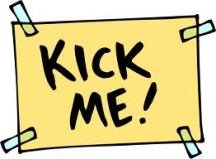April Folly
Everyone knows the phrase April Fools’ Day, and that it falls on 1st of April. Right? Not necessarily.
The most common myth about April Fools’ Day is that it began in 1582, when France adopted the Gregorian calendar, shifting observance of the New Year from 31st of March (around the time of the vernal equinox) to 1st of January. Owing to inadequacies of mass communication in sixteenth century Europe, many people continued celebrating New Year’s Day on 1st of April. These ‘April fools’ became the butt of jokes, and from that time, we have been celebrating April Fools’ Day.
Except it’s not true.
People were holding festivals for fools at this time of year centuries before Pope Gregory changed the calendar from Julius Caesar’s version. The Romans, for example, celebrated a muck-up day on March 25th known as Hilaria, an occasion notable for its masquerades, pranks and good cheer. At this part of the solar year in India the Hindus were celebrating Holi, the festival of colour, with merrymaking and a loosening of social norms. Likewise, the Jewish festival of Purim, also of some antiquity, coincided with the advent of spring in the northern hemisphere, and was an annual occasion for carnivals, costume-wearing and pranks. There is also a long tradition of foolery in Iran (formerly Persia, formerly Mesopotamia), where they have been playing jokes on the 13th day of the Persian New Year (which happens to be April 1st), since the 6th century AD, in a festival known as Sizdahbedar. Many scholars believe that this Persian tradition is the true origin of our modern April Fools’ Day.
In modern times, there have been memorable pranks and japes in the western hemisphere, such as news broadcasts about spaghetti farms, the introduction of metric clocks, and a proposed repeal of the law of gravity. It’s no accident that the Melbourne International Comedy Festival begins each year on April 1st.
This date has become a global occasion for merriment. In Poland, there’s a long tradition of hoaxes by citizens and the media, when serious activities are best avoided. This conviction is so strong that the anti-Turkish alliance with Leopold I, signed on 1st April 1683, was backdated to 31st March. In Sweden, the jokesters say “April April din dumma sill, jag kan lura dig vart jag vill” (April, April, you stupid herring, I can fool you to wherever I want). Swedish and Danish news outlets publish one false story each 1st April (as do quality Australian newspapers, such as The Age). In France, children attach paper fish to one another’s backs as a prank, calling out ‘Poisson d’Avril!’ (April Fish), because fish are a traditional feature of April Fools’ Day in France (young fish being easy to lure and catch). In Scotland, April Fools’ Day is 48 hours long and the gullible fool is called an ‘April Gowk’ (another name for a cuckoo). The second day is called Taily Day, dedicated to pranks involving the buttocks, like the old ‘kick me’ sign. There’s a Flemish tradition where children lock out parents or teachers, only letting them in if they promise to bring treats the same evening or the next day. Britons (and Australians) used to be taught the tradition of ‘April fool’ on the understanding that such jests lasted only until midday, after which time any prankster who persisted in joke-making then became the April Fool. This tradition seems to have lapsed in recent times but not the date for merrymaking in general.
If we look to the Roman festival of Hilaria as one possible origin for April Fools’ Day, we must acknowledge that, as in so many areas, Rome borrowed heavily from Greece. The Greeks had a festival called ΑΝΑΒΑΣΙΣ (Ascensus). The Romans adapted this into Hilaria, a celebration held on the vernal equinox to honour the goddess Cybele, an earth mother figure (magna mater). There were other kinds of Hilaria celebrations, so the full title of this one was Hilaria Matris Deum, celebrated on March 25th, the eighth day before the Kalends (first day of the month, from which we derive the word ‘calendar’) of April. A solemn procession to honour the goddess was then followed by games and amusements, including dressing up as public figures.
This tradition of folly has another strand, at the other end of the kalendar, called the Feast of Fools. It has various names (such as festum fatuorum or fête des fous), and was celebrated across Europe. A successor to the Roman festival of Saturnalia, it represented a mini-revolt each year in late December, when trappings of power were conferred upon those of inferior status. Young people would play the main roles, including a mock pope, mock bishop or mock abbot to reign for a day as the Lord of Misrule. Titles abounded, such as Archbishop of Dolts, Abbot of Unreason, Boy Bishop or the Pope of Fools. Other performers, dressed in different kinds of masks and disguises, practised revelry within the church building. The shifting date of the Christmas season, prior to the adoption of the Gregorian calendar, meant that in some places the Feast of Fools occurred on the Feast of the Circumcision, on 1st January. Though the origins of this festival are obscure, scholars believe it grew out a ‘festival of the subdeacons,’ around 1st January. Deacons held their own celebration on St Stephen’s day (December 26th). Priests had St John the Evangelist’s day (December 27th). Choristers and mass-servers had the Feast of the Holy Innocents (December 28th). So the subdeacons (lowest of the church pecking order) held their celebration on or about the festival of the Circumcision (Jan 1st). The Feast of Fools with its blasphemous extravagances included condemnations of the medieval church. Authorities were keen to eradicate it but this pagan tradition, in imitation of Saturnalia, was deeply rooted in medieval culture. While the Feast of Fools didn’t appear in official church documents, there is plenty of extant historical evidence for its popularity. After much cracking down and Inquistioning by the church, the Feast of Fools was finally suppressed, though instances of fools’ festivals survived in France well into the seventeenth century. Victor Hugo successfully recreates one Feast of Fools from 1482 in The Hunchback of Notre Dame (1831), in which Quasimodo serves as the King of Fools.
But here’s where the fool jumps around that medieval calendar like a court jester.
In Spain and Latin America, people might know the term April Fools’ Day, and they might recognise April 1st as a day for pranks in other countries, but in Spanish tradition, it’s 28th December (time of the Lord of Misrule and Saturnalia) when they play jokes on one another. This is a Christian day of celebration called the Day of the Holy Innocents. After somebody perpetrates a prank, the joker will call out “Inocente palomita que te dejaste engañar” (You innocent little dove that let yourself be fooled). In Mexico, it’s “Inocente para siempre!” (Innocent forever!). In Argentina, it’s “Que la inocencia te valga!” (roughly translates ‘don’t be so gullible’). In Spanish, the epithet Inocente! may mean either ‘Innocent!’ or ‘Gullible!’
Saturnalia is the best-known of festivals from the ancient world characterised by role reversal and behavioural licence. On the occasion of Saturnalia, slaves were treated to banquets of a kind usually reserved for their masters. Master and slave might even dine together. Sometimes on Saturnalia, slaves feasted first and the masters served food. For one day, slaves could be exempted from punishment. Horace called this ‘December liberty’. Such levelling activity was temporary, with limits. No social norms were truly threatened. Role-playing included status reversals, mask-wearing and gambling for all, even for slaves. Rampant overeating and drink were the rule; sobriety the exception. There was a kind of Christmas spirit long before Christmas existed; with gift-giving commonplace, especially for children.
Then in 46 BC Julius Caesar reformed the calendar because it had fallen out of alignment with the solar year. He made January 1st the beginning of the year. That didn’t last. As Christianity spread through Europe, the church tried to Christianise the calendar by moving New Year’s Day to dates of greater theological significance, like Christmas or Easter. Yet some countries continued using January 1st, justifying it as the date of Christ’s circumcision. So by the 1500s, the calendar in Europe was a mess. Not only had astronomical miscalculations in the Julian calendar caused the solar year to diverge from the calendar year, many countries were commencing their civic year on different dates. The practice of beginning each year on Easter Day caused enormous practical inconvenience. During the sixteenth century, the French decided to revert to January 1st as the commencement of their calendar year but they knew it would take a transition period. So for a while they maintained a dual system of dating. It was common to see both forms of dating listed side-by-side in French texts of the period. Then in 1563, Charles IX decreed January 1st to be the first day of the calendar year, aligning legal convention with popular practice. Almost two decades later, in 1582, Pope Gregory XIII issued a papal bull decreeing widespread calendar reform. This meant not only asking everyone to move the start of their year to January 1st but also the creation of a leap-year system, and the necessity to eliminate ten days from the month of October 1582, which would correct the drift of the calendar. Though he lacked formal power to enforce this, the pope urged Christian kingdoms to do so.
So it looks like the myth of the April Fool has little basis in fact. Before and after Pope Gregory’s calendar change, French people celebrated the start of their year on Easter day (ever shifting), rather than April 1st, a date of no particular significance in France, unlike in Persia. The only conclusion left to draw is that our notion of April Fools’ Day has evolved from multiple traditions relating to spring festivals of renewal, in which pranks are common, and a general spirit of mirth associated with springtime. Time for a party. April 1st? Why not?
Red, White and Blue
This month, Prime Minister Tony Abbott announced a ‘repeal day.’ Promising to slash through red tape, he intends to eradicate more than eight thousand redundant or otherwise obsolete government regulations. This metaphorical red tape is allegedly strangling business productivity. Taking a leaf out of British PM David Cameron’s book, the Australian government says it will cut one billion dollars’ worth of red tape. Such a stunt in practice may not earn a fraction of that saving because most of these targeted regulations are no longer enforced. But it sounds impressive. Is this not the kind of thing that governments across the colour spectrum love to boast about? So, political posing aside, we might well wonder just what is ‘red tape’?
This is one of those figures of speech that belong to the category known as ‘metonymy,’ in which an object or concept (in this case ‘bureaucracy’) is not known by its own name but by the name of something associated with it. ‘Red tape’ implies excessive conformity to rules that thwart or hinder decision-making. The Department of Circumlocution in Bleak House (1853) by Charles Dickens is one such example. ‘Red tape’ is a curious little phrase, first recorded in English during the reign of Henry VIII. The king’s scribes bound His Majesty’s petitions to the Pope for annulment of that inconvenient marriage to Catherine of Aragon. These petitions were bound in red cloth tape, a practice already established in Spain. Today, many legal documents are still bound in red tape, though defence barristers’ briefs are tied with pink tape, while prosecuting counsels’ briefs are bound in white.
Speaking of that colour: why is a ‘white paper’ white? This is a report or guide compiled by topic experts to help the reader to understand a problem or to make a decision. White papers are commonly used in government and in marketing. Perversely, they are also sometimes referred to as belonging to the category of ‘grey literature,’ of which more anon. The first ‘white paper,’ so-named, seems to issued from the pen of the great Winston Churchill in 1922. The white paper is usually a form of policy document, approved by Cabinet, tabled in the lower house, and made available to the public. By contrast, the ‘green paper’ is a white paper not yet ripe, designed to stimulate discussion of policy and encourage consultation between parliamentarians for the purposes of information and analysis.
Now ‘grey literature’ is informally published material that is difficult to trace via published journals and monographs, though it may be an important source of information for researchers. Examples include patents, technical or scientific reports. ‘Grey literature’ lacks bibliographic control, such as author, publication date or publisher identification. Access problems have decreased since the proliferation of free research documents on the World Wide Web but problems persist when writers fail to document online reports or publications adequately (e.g. omitting a publication date or not assigning permanent URLs). This can leave the copyright status of many reports unresolved and ‘grey’. There has been a lot of work in the last decade to create a stronger repository and better access to grey literature, including the institution of a GreyNet (note the non-USA spelling of ‘grey’ – a small triumph for UK English).
Let’s not forget the blue book. This may refer to a journal or compilation of data. It’s a term dating back to the 15th century, when large blue velvet-covered books were used for record-keeping by parliament. ‘Blue book’ is also used in computer technology for telecommunications standards and other data compilations and protocols. It’s been used by the armed forces for signals intelligence, by trainee London cab drivers and by various US state almanacs. Also, the jewellery company Tiffany & Co publishes a ‘blue book’ catalogue.
Oh, and by the way, there’s a practice known as ‘redlining’. This term is used when banks or insurance companies deny access to health care based on socio-demographic lines on a map. It’s a form of discrimination or even racial profiling, and akin to the blacklist (there’s another colour bar).
So in theory, a government could issue a green paper on the subject of redlining, which could become a white paper, to be tabulated in a blue book. Supposing that white paper languished in the realm of grey literature, red tape might present a barrier to access, especially if the authoring agency is blacklisted. There is something to be said for cutting the Gordian Knot.
Hack to the Future
Recently I came across the term ‘life hacking’. Urban Dictionary defines this term as ‘the act of making small tweaks to everyday activities in an effort to make them easier and more efficient. Oftentimes this can be computer or desktop related, but is not entirely so.’
Then I began to wonder about that funny little word ‘hack’.
Though common in digital-age discourse it has more branches than a giant eucalypt. Not only does ‘hacking’ continue to proliferate in new applications across the sciences, it inhabits diverse spheres of influence. And it’s been doing this for at least a couple of centuries. For example, lovers of Victorian-age literature might have encountered it as a synonym for London taxis, as in ‘hack and pair’ or ‘hackney carriage.’ One origin theory suggests an anglicized version of the French word haquenée, which denotes a medium-sized horse suitable for ladies to ride sidesaddle. An equally plausible derivation source is the village of Hackney in Middlesex, which has been swallowed up by the conurbation of Greater London. Hackney used to be known for its horses and horse-drawn carriages.
One may be a Hack without being a hack. It’s a surname as well as a first name. There are sportsmen, scientists and authors called Hack, though as far as I know not one is famous as a hacker. Yet builders may be hackers. As a noun, ‘hack’ is a construction term used in masonry to signify rows of stacked unfired bricks or their covers.
‘Hack writer’ has been around since at least the eighteenth century. Sometimes referred to as ‘Grub Street’ writers, these were wordsmiths paid to churn out low-quality material. Pot-boilers in the form of pulp-fiction and bodice-rippers were assembled in short order by hack writers for a cheap print-run, usually to a deadline. An early hit song by The Beatles called ‘Paperback Writer’ describes just such a hack. This use of the word is obviously pejorative, yet it is curious how the term derives from the same source as ‘hackney,’ suggesting a horse that was both easy to ride and available for hire. ‘Grub Street’ was a thoroughfare in East London’s Moorfields district, a demimonde of dodgy publishers, scribes for hire and would-be poets in bohemian flops, brothels and coffee-houses. Elsewhere the Grub Street hack has popped up to pay the bills of starving scribblers in their metaphorical garrets around the world. Anton Chekhov wrote articles for the so-called ‘yellow press’ (from its low-grade print paper, these days associated with excesses of tabloid journalism). Samuel Beckett translated items for the French edition of Reader’s Digest. F. Scott Fitzgerald and William Faulkner squandered their narrative gifts on second-rate Hollywood scripts.
Comedians can be hackers in this sense too. Joke thievery, a form of plagiarism, is slightly easier to detect in today’s YouTube global society, but it’s a form of hacking. This use of ‘hack’ is a joke which has been stolen, and used without the writer’s permission. Copyright infringement may be hard to prove in such cases, especially when the ‘originator’ has himself adapted and updated a comedy routine that has been doing the rounds for some time. It’s not unlike the phenomenon of a folksinger in the oral tradition adapting and augmenting songs from other adaptors and augmenters who pass down the song to a new generation of ‘re-interpreters’ and ‘improvers’. Hacking in this sense is hardly breaking and entering, more like walking in to borrow from a free library.
‘Hacking’ also turns up in the art of falconry, whereby a trainer helps young birds to achieve hunting potential by providing specifics forms of exercise. ‘Hacking’ appears in another and unrelated sport. It’s the name of a particular equestrian activity that ‘describes’ the act of riding a horse for light exercise. It’s also applied to a type of horse-show. Is there a connection back to Hackney?
Technology ‘hackers’ were around before computing began, though they weren’t known by that term. As far back as 1903, a magician and inventor called Nevil Maskelyne disrupted a demonstration of Marconi’s ‘secure’ wireless telegraph by sending rude Morse-code messages through the auditorium. Code-breakers of the Nazis’ so-called ‘unbreakable’ Enigma code did not receive the title ‘hacker,’ though that’s what they were. Only when computer culture flourished in the 1980s did the term ‘hack’ enter its modern phase. In the mainstream media, ‘hacker’ soon became linked with computer viruses and electronic vandalism to mainframes and networks. Software security was big business. Reformed hackers earned big bucks by helping corporations and government agencies to design various forms of protection. ‘Worms’ and ‘Trojan horses’ entered the language of hacking. Cyber warfare became a new front in the geopolitical-military game of statecraft. Hackers cracked codes of financial systems, military networks and guidance systems of unmanned satellites and aircraft. Hackers were frontline soldiers in a new war.
The good-guy hackers became known as ‘white hat’ hackers, leaving those wicked black hats for the bad guys. Many white-hatters would prefer to reserve the term ‘hacker’ for the forces of niceness (to paraphrase Maxwell Smart), and like to refer to the burglars of computer systems who do so for no better reason than fun as ‘crackers’. The ‘black hat’ hackers have included terrorist organisations, nation states and organised crime networks. Good-guys in white hats have branched out and are extending the use of ‘hacker’ as a title for benevolent researcher in such diverse fields as molecular biology, geo-engineering and genetics. The verb ‘to hack’ has left the technology stable altogether, and even entered the realm of social behaviour. ‘To hack’ can mean to exploit—without permission—the roofs and tunnels of public buildings for political purposes. People have been known to ‘hack’ high-rise buildings or landmark monuments, such as the Sydney Opera House, draping them in message banners or daubing paint. Is this putting on a black hat or white?
The other legacy of an extended positive definition of hacking is the use of ‘hack’ as a verb to indicate fixing or improving a system. To ‘hack’ may now mean to ‘tinker,’ ‘explore,’ ‘dissect,’ ‘analyse’ and ‘intervene’. This brings me back to the phrase ‘life hacks’: a science-y way to describe handy hints for efficiency improvements in domestic and sartorial repairs.
In one sense, the term has come full circle, as it began as a word for easy transport and helpful methods of improvement, in various unrelated disciplines. But in another way, the word has been released from its technology origins to become a way of living. Nowadays, a ‘hacker’ may just be someone who revels in playful cleverness. His or her defining characteristic isn’t the context but the whimsical attitude, with a disdain for traditional authority. Life hacks unite.
Who were they and how did they do it?
It is a truth universally acknowledged that English began with the Angles, Saxons and Jutes. But how did they manage it? Weren’t two other languages thriving at the time? Why did these vanish when other conquests of a similar nature did not produce linguistic armageddon?
For starters, who were the Jutes? Nobody seems to have heard of them outside the pages of Bede, that venerable chronicler who died in AD 735. According to the man dubbed ‘father of English history,’ a tribe called the Jutes originated in Jutland on the North Frisian coast (now part of Denmark). Bede claimed they were one of three tribal groups from German-speaking countries to invade Britain in successive waves during the late fourth century AD. But historians since Bede have been sceptical about this. Some believe that Jutish folk were merely a branch of the Saxons; others have confidently asserted that Jutes were in fact Geats from southern Sweden. Did a people called the Jutes really invade England? There’s far stronger evidence for the presence of Frisians, whose modern dialect includes words that bear a remarkable similarity to spoken English. Dear old Bede remains the only historical evidence for a people called the Jutes as a separate ethnic strain from the Saxons. As for his claims of Jutes settling in Kent and on the Isle of Wight, burial evidence shows a closer resemblance to Roman and Frankish influence than the Angles or Saxons. Let’s not put our money on the Jutes.
Which brings us to the Angles, who gave their name to the country and the language. As a people, this tribe is only a tad less obscure than the Jutes. The name seems to have originated in Angeln (roughly in the Schleswig-Holstein region of modern Germany). The name was first recoded by Tacitus as Anglii. Rather than an angelic derivation, it either comes from the German term for ‘narrow water’ or ‘hook’ (as in angling). The Latinised word Anglia (or ænglia) was used for centuries, its ‘ae’ ligature morphing into ‘e’ (like Aethelbert and Aethelred) for ‘Englaland’. Tacitus is not specific about their exact origin but Ptolemy places this people near to the Saxon tribes. Later scholars believe that the Anglii lived in the southern Baltic, near where Jutes were alleged to come from. Evidence for a separate people from the Saxons is inconclusive at best.
As a tribe, the Saxons were and are better known. But were they discrete from other Teutonic tribes of the region? Ptolemy mentions ‘Saxones,’ though some extant copies of his Geographia transcribe this as ‘Axones’. Certainly the term ‘Saxon’ became the generic name for German-speaking invaders in the fourth century, whether from the Rhine or the Baltic. So whatever their exact identity they became the dreaded Saxon foe of Arthurian legend and the ‘Sassenach’ conqueror of the Scots.
The bigger puzzle is how these Germans managed it. Military conquest is one thing but this series of raiding parties succeeded in wiping out two entire languages in a sustained cultural takeover, to a degree both improbable and unprecedented throughout the whole Roman Empire. While civilised Latin retreated into monastic enclosures, what we now call Celtic or Gaelic (or Cymraeg) withdrew either to the mountains of Wales or pockets of resistance in Scotland (Caledonia) and Ireland (Hibernia), as well as Cornwall and Brittany. In fact the remaining Britons in the western peninsula were called ‘walhaz,’ which means ‘foreigner.’ The words welisċ, wælisċ and wilisċ, for Romano-British, came to be known as Welsh.
Even on military terms, a Saxon victory seems unlikely. How could these raiding parties defeat not only the Roman army—the known world’s best fighting force—but also Romanised British chieftains (Arthurian types) combined with untamed Celtic warriors, generally a tough breed? Just how did the Saxons manage it? Were they that good? Did they have an inexhaustible supply of warriors and weapons? Were they superhuman?
Their success was even more devastating on the cultural front: utter assimilation. Saxon invaders wiped out the Romans and the Britons culturally and linguistically. But how exactly?
Conquest did not happen this way anywhere else. The Danish invasion of the 9th Century did not result in the eradication of Anglo-Saxon. And in 1066, military and linguistic takeover by the French Normans failed to achieve such devastating finality. The mystery of how Saxon England wiped Britannia from the map still puzzles historians as well as linguists. When the Gauls drove out the Romans, people kept on speaking Latin as well as Frankish, which slowly merged to develop into French, among other dialects. And the same pattern unfolded on the Iberian Peninsula. Elsewhere in the crumbling empire the various tribes of Goths, Visigoths and Vandals did not succeed in eradicating whole languages from their lands of conquest. So how did guerrilla bands of uncertain German provenance achieve linguistic extermination in Britannia? We know it happened but we still don’t know why: one of the enduring mysteries of our culture. We may hypothesise but as yet we lack a substantial body of scholarship to tell us why English came into being with barely any trace of the languages of Britain.









